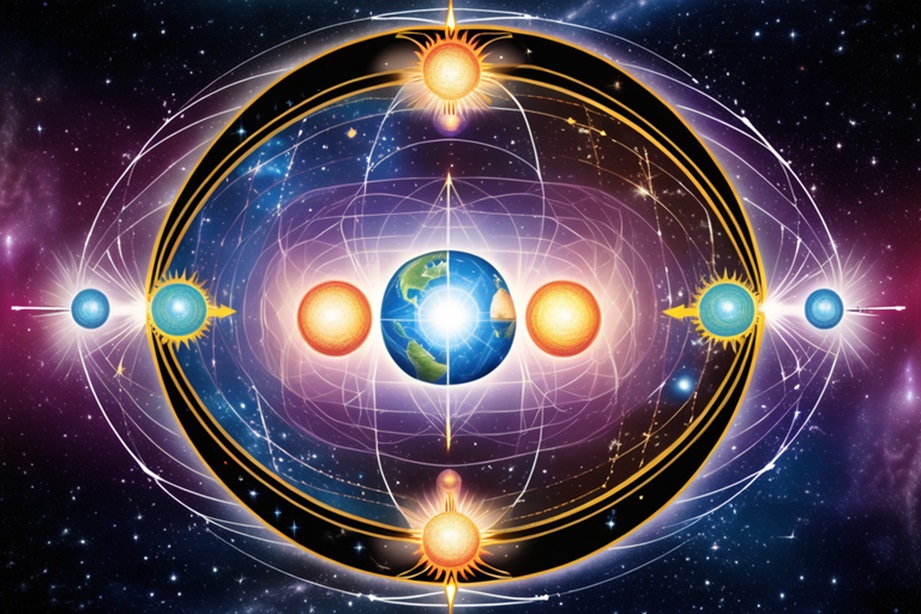In the state of passive identification we feel the need to adhere to some kind of security-producing, pre-formatted, unambiguously-defined ‘two-dimensional surface’. If there is no such defined surface for us to adhere to, to cling to, then we see this as a situation that we can’t work with. Faced with the lack of a defined surface to adhere to we panic, we fall into groundless anxiety. We don’t know what to do, what to think.
The one thing reality does lack is a clearly-defined outline or surface. Reality has everything else but this. What we do to get around this lack is that we create the defined surface we want via the operation of the logical mind which by its very nature functions in terms of definitions, in terms of boundaries, edges, outlines, and closed categories. Logic itself is a ‘defined surface’.
Once logic has created the defined surface then all we have to do is follow it, obey its dictates without hesitation, without refection. This is like joining the army, and then simply doing everything you are told to do. Or it is like joining a cult, and then believing everything you are told to believe. Once we have conformed to the black-and-white logical world, there will no longer be any cause for insecurity, any cause for uncertainty or indecision. On the face of it then, it looks like the awkward problem posed by unconditioned, unformatted reality has been effectively solved, effectively circumvented.
We might assume therefore that ‘all will be well’ just so long as we place all our trust in the operation of the logical mind, but this is very far from being the case. Logic is a funny sort of a thing – it is by no means as straightforward as we take it to be. It is straightforward ‘on the outside’ but very tricky indeed on the inside. Logic has a sting in its tail, it has a trick up its sleeve. Logic is – although we almost never see it – inherently and irreducibly paradoxical.
We would see this very plainly if we were able to see the whole ‘logical surface’ all in the one go, all at the same time, but this is the one thing we never do see. That would be like seeing a coin up in the air, spinning, instead of seeing it lying down on the table with only one side showing. If we were able to see the whole logical surface all in the one go then what we would see is that it is actually a Mobius loop. A Mobius loop has a structure that has a very good go at pretending to have two distinct and unconnected surfaces whilst actually only having the one. When we look at this paradoxical structure in a casual way all we see is the regular type of a loop – the type that appears to have both an inner and an outer surface. When we look at it more carefully however we see that there is a kink in the loop which means that there is only the one surface twisted around on itself.
Logic is like a Mobius loop because it appears to have two distinct surfaces whilst actually only having the one. It appears to have ‘the surface that is made up of positive statements’ and ‘the surface that is made up of negative statements’ and these two possibilities present themselves as being quite different from each other. If I say, for example, that the answer to a particular logically-defined question is “Yes” then according to the explicit laws of logic (known in classic Aristotelian philosophy as ‘the law of the excluded middle’) the answer to the question cannot at the same time be “No”. If the cat is in its basket then it cannot at the same time be not in its basket.
Thus it appears that the space or domain occupied by the affirming answer to the question is separate from the space or domain that would be occupied by the denying answer. As far as the explicit laws of logic are concerned YES and NO are fundamentally different from each other, which is to say, there is an actual discontinuity between them. As far as the laws of logic are concerned there exists an insurmountable gap between the two opposites.
The truth is however – if only we could pull ourselves back far enough from the logical surface to see it properly – that the two apparently discontinuous surfaces actually constitute the one seamless logical continuity. If I say that the cat is in the basket, or if I make the contrary statement that the cat is not in the basket, neither of these statements, either affirming or denying, in any way challenge the viewpoint on the world out of which the statements arose. Both are equally unchallenging of the categories of the mind which makes the statements – in fact YES versus NO is how that mind works. We could say that the logical mind operates by drawing boundaries, and each boundary that it draws is intrinsically made up of YES and NO. If the cat’s basket is ‘the category’ then when the cat is in it, that is YES and when the cat is outside it, that is NO. Both possibilities, therefore, equally affirm the reality of the basket.
That’s all there is to a logical category – YES/NO, just as INSIDE/OUTSIDE is all there is to a defined boundary. It is as uncomplicated as that. Of course, there is the set of criteria that is associated with the category, the rules which determine what elements belong in the category, but this is really only equivalent to the question of where we draw the line, where we place the boundary. What we choose to put in the category (where we choose to draw the line) has nothing to do with what a category or boundary actually is however. It has nothing to do with it’s actual essential nature, which is that of a pair of complementary opposites (+/-, IN/OUT, UP/DOWN, RIGHT/WRONG, etc), which exist side-by-side in some sort of abstract space. [The reason we can say that the pair of opposites which go to make up a boundary exist in it is an ‘abstract’ space is simply because in ‘non-abstract’ space the opposites are not separated, cannot be seen as different things, and thus do not go on to create a continuum of different possible positions on a polar axis, or set of axes.]
What is more, the two opposites (whatever pair of opposites we choose to pick) are not in any way different from each other, which is something that we are profoundly averse to seeing. This hidden identity can however be readily demonstrated: if two football teams are playing a match and after the match I ask the question “Which team has won, Team A or Team B?” you will either answer “A” or “B” (assuming that the match wasn’t a draw). If Team A has won then Team B hasn’t won, and vice versa. So when I say YES to one possibility I am at the same time I am saying NO to the other, which means that saying YES is the very same thing as saying NO.
So what’s the difference between YES and NO? It is totally arbitrary which possibility we call YES and which we call NO. After all, all we are doing by this is designating which side of the boundary the possibility exists on and both sides of the boundary are intrinsically the same, even if we do choose to name them differently. They are – when it comes right down to it – only ever ‘the two sides of the boundary’ and this is a quintessentially symmetrical situation. Whether I give all the numbers on one side of zero on the number line a positive value or a negative value makes not the slightest bit of difference – I could equally well do it either way around since the only thing I am doing by this is designating which numbers are on side and which are on the other. The set of positive integers and the set of negative integers are mirror images of each other, as everyone knows. [+] and [-] are symmetrical and this means that there is no difference between them.
The point is therefore that YES and NO are not in any way intrinsically different from each other, even though we take it totally for granted that they are. The game that we play is that they are different, but the whole thing about a game is that it is true only because we have chosen for it to be true. To call YES YES and NO NO is a mere convention, just as calling one direction UP and the reverse direction DOWN if we happened to be living on an object floating in space (which of course we are). YES is the flip-side of NO and NO is the flip-side of YES and that’s all there is to it. That’s the most we can say about them…
This shows us something that is tremendously, astonishingly significant. Since YES and NO are the same thing (i.e. since they are only really the ‘two sides of the same coin’) this means that logic only really has the one surface to it. It only has the one surface, which is the YES/NO surface, which is an unbroken continuity that joins up with itself with a kink in it, just like a Mobius loop, or Mobius strip. YES/NO is a continuity not a discontiunuity.
If we fail to see that the defined surface presented by the logical mind is closed and that it joins up with itself with a twist built into the loop somewhere, then naturally we imagine that sticking with YES will take us somewhere totally different to NO. We imagine that it is a bus with a totally different destination. Not seeing the identity of the opposites has consequences, the most obvious consequence being that we never actually get anywhere, that we go around in circles without realizing it. Our attitude is that we are ‘taking care of the pennies and leaving the pounds to take care of themselves’ – we concern ourselves with the detailed view and imagine that the bigger picture will sort itself out as a result. We put all of our attention into dotting all the ‘i’s and crossing all the ‘t’s. We have the idea that by scrupulously taking care of all the minutiae progress will inevitably take place on the larger scale of things.
This however is not at all true. All the stuff we pay attention to exists only on the defined surface that is presented to us by the logical mind. The only world we know (and care about) is the defined world, the measured and categorized world, the conceptualized world, the world which is the ‘output’ of the central rational processing unit of the thinking mind. We don’t (or at least very rarely) register any other world. We don’t (or at least very rarely) have any interest in any other world. The consequence of this lack of awareness and lack of interest is of course that we are restricted to the ‘Mobius Loop-World’ which is the correlate of the Mobius Mind. We are restricted – without knowing it – to a closed and self-cancelling system which is the product of the self-contradicting (or ‘paradoxical’) logical mind. This is the ‘null-world’ of the system of thought, this is ‘the nullity’.
The more rigorously and scrupulously we operate the thinking process the tighter we make the loop, and the tighter we make the loop the more we exclude everything that doesn’t have a specified and authenticated place on the ‘definite surface’ that the thinking process has provided our attention with. The more rigorously (or obsessively) we think, the more of reality we exclude, and thus the more our world shrinks, the more it is removed from reality, the more it is turned into an abstract game. Rational thinking drives out reality, just as a convoy of fast-moving police cars with sirens wailing and lights flashing would drive out a burglar from the house he is attempting to burgle!
What the logical mind excludes is space. Logic has to do this – logic can’t actually be logic is there is any space there in the mix. Logic and space don’t mix (at least not on logic’s terms). Another way of explaining this is to say that what logic excludes is perspective because if it didn’t exclude perspective then all of its statements would be immediately shown up to paradoxical, self-contradictory, self-denying, self-cancelling, and therefore null. If logic didn’t exclude perspective then it would become possible to see straightaway that that instead of two surfaces, the logical system has only one. This is like seeing a coin flipped up right into the air, where it hangs spinning in an eternal moment of time, so we can clearly see both sides at one and the same time!
Perspective arises out of discontinuity, which is another way of talking about otherness. If perspective is excluded then all discontinuity is excluded, and this means that any sense of otherness is being excluded. When there is no genuine (i.e. radical) ‘other’ then everything has to be defined ‘in terms of itself’, which is the recipe for tautological meaning. Tautological meaning is however a trick – it appears to be meaning, but when we examine it more closely we see that it is not meaning at all. If no discontinuity, no otherness is permitted, then all signifiers will be literal rather than symbolic – they will mean ‘exactly what they say they mean’ rather than referring obliquely to something that we cannot know about. Since the rational mind understands (and communicates about) everything in terms of its signifiers, its categories, this necessarily means that the only type of meaning possible in a strictly logical system is meaning of the deceptive or tautological variety.
The result therefore of ‘playing it safe’, avoiding radical uncertainty, and scrupulously adhering to the defined (and thus security-providing) surface generated by the logical mind is that we enter into a null world that we cannot see as such, an illusory system of meanings that we cannot see to be illusory. Because we are so scrupulous in following the lead of logic, and conforming obediently to its dictates, we lose all perspective. The result of losing all perspective is that we can no longer see that the world we have conformed or adapted to is a perspectiveless one, a ‘world without perspective’. We cannot therefore see that this world has no actual content.
Because of our ‘flat’ vision we only see half the picture, and because we do not know that our vision is flat we cannot help thinking that what it shows us is the whole picture. Because we adhere so faithfully to the world that has been presented to us by the system of logic we are compelled to act out its paradoxicality in our lives, without seeing that this is what we are doing. We are compelled to travel in futile, self-defeating circles without clearly seeing that this is what we are doing (even though from time to time we might suspect it). Because we are ‘playing it safe’ we are compelled to put all our energy and time into creating ‘definite structures’ which we unreflectively identify with, but which are in their very nature wholly self-contradictory or self-cancelling.
Since we are identified with these structures we feel good because of them, and to exactly the same extent we feel good because of them, we also feel bad because of them.
As the existential psychotherapists say, the only thing that keeps us from breaking free from this appallingly sterile self-cancelling, endless and ultimately illusory circle of euphoria and dysphoria is our fear of Reality, which is forever undefined, which is a true discontinuity, and which is on this account never represented for us on the definite closed surface provided for us by the Mobius Loop of the logical mind.






